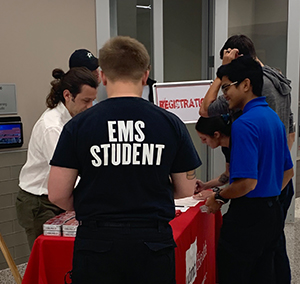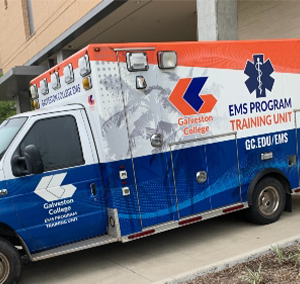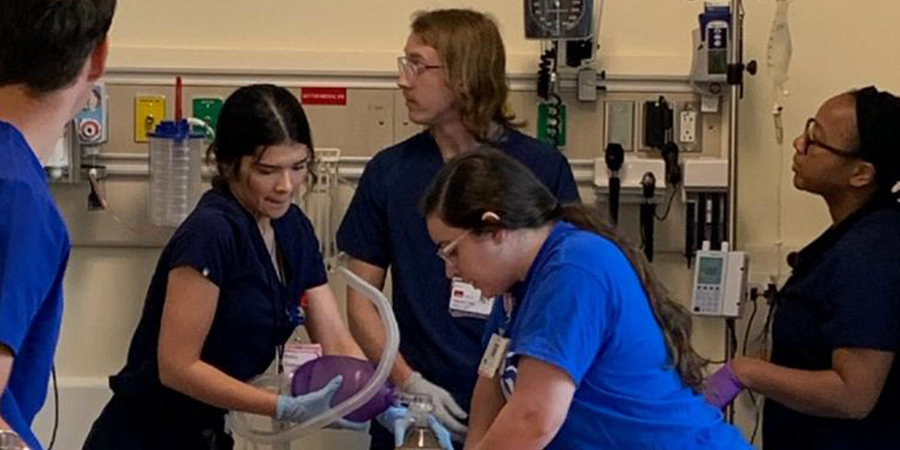May 6 was a beautiful day for a mock disaster.
“The sky was blue, and a cool breeze kept the spring heat at bay while a volunteer playing the part of a perpetrator was preparing to lay siege to the building that houses the Osher Lifelong Learning Institute on UTMB Health’s Galveston Campus.
Scores of health care students, EMS personnel and other emergency responders prepared to care for the “wounded” and calm the “worried well” who were congregating at the nearby Health Education Center.
Just after 10 a.m., the mock active-shooter event led to “victims” spilling out of the OLLI building and into the parking lot. Medical personnel responded, while a police chase ended in a car wreck and more injuries.
Inside the Health Education Center, the mock ER filled up fast. Those victims whose faked injuries allowed them to walk and wait did so, as others were hurried by on gurneys.
Inside, students from the School of Nursing, John Sealy School of Medicine and School of Health Professions pretended to lift the human actors onto beds then proceeded to administer emergency care to the mannequin patients that took their place. Once attention turned to their simulated counterparts, the bloodied volunteers shuffled down the hall to the moulage room where their “injuries” were first created.
A few hours later, all the “wounded” had cleared out, the makeup used to create their wounds was cleaned off and everyone walked away with as real a feel for a true large-scale disaster as possible.
Funded by the UTMB Health President’s Cabinet Award, “Learn Together to Work Together: Saving Lives Through Interprofessional Education,” Disaster Day 2023 combined a multiagency disaster response scenario with a UTMB Health police active-shooter drill. It involved law enforcement, the fire department, emergency response teams and medical students and staff and tested not only their individual efficiency but also the working relationships among the groups.
Entities involved included the UTMB Health Police Department, Galveston Police Department, Galveston Area Ambulance Authority, Galveston Fire Department, Galveston College EMS Professions Students, UTMB Health faculty and UTMB Health students.
“Our overarching goal with Disaster Day is to take everyone out of their comfort zone and to better understand what role they play in response to a multicasualty incident,” said Chris Connolly, the third-year medical student who acted as chief commander of the event.
“These events are inherently interprofessional, and we wanted to put students and first responders in a situation where they could practice working together,” he said. “We worked very hard to make this event valuable for everyone involved, and their support and enthusiasm for interprofessional collaboration enabled us to be successful.”

UTMB Health Police outlined the active shooter scenario and how that would play out, while medical students wrote the case scenario for each victim.
Action in the ER was guided and overseen by UTMB Health medical staff and faculty.
To reduce burnout, the agency tries to schedule a medic to work on Galveston Island one day and then put that person at a slower station in the county the next day. That’s because island crews run between 15 to 20 calls a day.
First-year Respiratory Care School of Health Professions student Devin Dallas was one of two incident commanders for the day, working to pull the event together and get community partners involved. She was the only respiratory care student involved and said it was interesting to work with nursing students to see how they would respond in a similar emergency.
“It definitely feels like it’s preparing me to see these situations in real life,” Dallas said during the event. “Obviously, these things are happening more and more, so it’s really good to see this before it’s actually real.”
Disaster Day was intended to prepare students not only for the extreme situation of an active shooter event but any kind of multi-casualty incident, or MCI. “The more practice we get in, the better prepared we are if the real thing comes to our door,” Connolly said. “However, getting students exposed to an MCI also prepares them for some of the everyday realities in health care. Working in an interprofessional team is a core part of health care— we’re a group of professionals with different backgrounds, different training and different priorities working toward the same goal.”
To that end, organizers were deliberate in their efforts to recruit students from all five UTMB schools and EMS students from Galveston College’s EMS program. The idea was to create a collection of health care students with different career paths—similar to what they’ll see in their future careers and put them in a position to learn from each other.
“Adding in the stressful environments of field triage and emergency care was likely a challenge for many, but it was also very important as it mimics what can happen in a real health care environment,” Connolly said. “Large influxes of patients can happen at any time, for any reason. Having a faculty-guided experience like this one gives them repetitions that will help them better see their strengths and weaknesses working in interprofessional teams.”
Student leaders worked on planning for the event for six months—an intense effort that paid off.
To do that takes muscle memory, not just brain knowledge. Online training plus hands-on practice helps the crews get both.
Much of the training at the Galveston Area Ambulance Authority is quality-assurance driven. When the team assesses quality assurance, they can see what training the crews might lack. Then the training officer builds a program to improve that knowledge and skills.

“Both event staff and participants adapted well to the planned and unplanned challenges we experienced during the exercise,” Connolly said. “We received great feedback from our participants, and we’re confident that the next group of student leaders can continue to develop this concept to make Disaster Day even better.”
This story first appeared in Health System Heartbeat, a newsletter for UTMB Health System employees.
